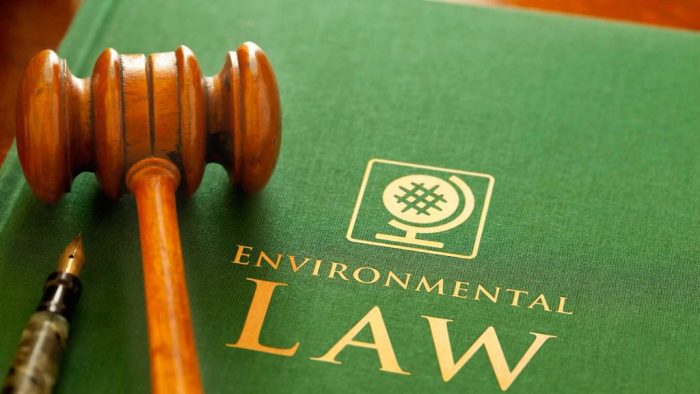International Environmental Law stands at the forefront of global efforts to protect our planet and ensure a sustainable future. This dynamic field encompasses a vast array of principles, regulations, and institutions that govern the international community’s response to environmental challenges.
As we delve into the intricate tapestry of International Environmental Law, we will explore its historical evolution, core principles, key areas of focus, and its crucial role in addressing pressing issues such as climate change. Along the way, we will uncover the challenges and opportunities that lie ahead, and consider how this evolving legal framework can continue to safeguard our environment for generations to come.
Historical Development of International Environmental Law
The origins of international environmental law can be traced back to the late 19th century, with the emergence of concerns about transboundary pollution and the conservation of natural resources. The first international agreement specifically addressing environmental issues was the Convention for the Protection of Birds Useful to Agriculture, signed in 1902. This was followed by a series of treaties and agreements aimed at protecting specific species, such as the International Convention for the Regulation of Whaling (1931) and the Convention on International Trade in Endangered Species of Wild Fauna and Flora (CITES) (1973).
The 1972 United Nations Conference on the Human Environment in Stockholm marked a watershed moment in the development of international environmental law. The conference led to the establishment of the United Nations Environment Programme (UNEP) and the adoption of a number of important principles, including the “polluter pays” principle and the precautionary principle. In the years since Stockholm, international environmental law has continued to evolve, with the adoption of numerous treaties and agreements addressing a wide range of environmental issues, including climate change, biodiversity loss, and pollution.
International Environmental Law is a fascinating field that seeks to protect our planet and its resources. However, when it comes to understanding the intricacies of foreclosure laws, it’s important to consult local experts. Check out Foreclosure laws in my state to stay informed about your rights and responsibilities as a homeowner.
After all, protecting your property is just as crucial as safeguarding the environment.
Key Milestones and Events, International Environmental Law
- 1902: Convention for the Protection of Birds Useful to Agriculture
- 1931: International Convention for the Regulation of Whaling
- 1972: United Nations Conference on the Human Environment in Stockholm
- 1973: Convention on International Trade in Endangered Species of Wild Fauna and Flora (CITES)
- 1987: Montreal Protocol on Substances that Deplete the Ozone Layer
- 1992: United Nations Conference on Environment and Development (UNCED) in Rio de Janeiro
- 1997: Kyoto Protocol to the United Nations Framework Convention on Climate Change
- 2015: Paris Agreement on climate change
Role of International Organizations and Treaties
International organizations and treaties have played a crucial role in the development of international environmental law. The United Nations Environment Programme (UNEP) has been the leading international organization responsible for coordinating global efforts to address environmental issues. UNEP has played a key role in developing and implementing international environmental agreements, providing technical assistance to countries, and raising awareness of environmental issues.
International Environmental Law plays a crucial role in addressing global environmental issues. Clean Air Act Compliance is a vital component of this framework, ensuring that air pollution is regulated and controlled to protect human health and the environment. Compliance with such laws is essential to uphold the principles of International Environmental Law, fostering a sustainable and healthy planet for future generations.
Treaties are legally binding agreements between states that set out specific obligations and commitments. Treaties have been essential in establishing the framework for international environmental cooperation and in setting standards for environmental protection. Some of the most important environmental treaties include the Vienna Convention for the Protection of the Ozone Layer (1985), the Montreal Protocol on Substances that Deplete the Ozone Layer (1987), the United Nations Framework Convention on Climate Change (1992), and the Convention on Biological Diversity (1992).
Principles of International Environmental Law
International environmental law is underpinned by a set of core principles that guide its development and implementation. These principles provide a framework for addressing environmental issues and promoting sustainable development.
Sustainable Development
Sustainable development is a key principle of international environmental law. It aims to balance economic growth with environmental protection and social equity. Sustainable development recognizes that the needs of present and future generations must be met without compromising the ability of future generations to meet their own needs. This principle has been incorporated into many international environmental agreements, including the Rio Declaration on Environment and Development.
Equity
The principle of equity recognizes that all countries have a right to a clean and healthy environment. However, it also acknowledges that countries have different levels of responsibility for environmental degradation. Developed countries, which have historically contributed more to pollution and environmental damage, have a greater responsibility to take action to address these issues.
Common but Differentiated Responsibilities
The principle of common but differentiated responsibilities is related to the principle of equity. It recognizes that all countries have a shared responsibility to protect the environment, but that developed countries have a greater responsibility due to their historical contributions to environmental degradation. This principle is reflected in many international environmental agreements, such as the United Nations Framework Convention on Climate Change (UNFCCC).
Precautionary Approach
The precautionary approach is a principle that aims to prevent environmental harm even when there is scientific uncertainty about the potential risks. This principle is based on the idea that it is better to err on the side of caution when it comes to protecting the environment. The precautionary approach has been incorporated into many international environmental agreements, including the Cartagena Protocol on Biosafety.
Key Areas of International Environmental Law
International environmental law encompasses a broad spectrum of issues, addressing the preservation and protection of the natural environment at a global scale. It establishes a framework for cooperation among nations to tackle environmental challenges that transcend national boundaries.
International Environmental Law addresses the preservation of the environment on a global scale. It includes laws governing hazardous waste management, such as the Hazardous Waste Management Laws , which aim to control the generation, transportation, treatment, and disposal of hazardous waste to minimize its impact on human health and the environment.
These laws are crucial components of International Environmental Law, ensuring that hazardous waste is handled responsibly to protect the planet and its inhabitants.
Regulation of Air Pollution
Air pollution poses significant risks to human health and the environment. International environmental law sets standards and guidelines to control air emissions, including greenhouse gases and other pollutants. The Kyoto Protocol and the Paris Agreement are notable examples of international agreements aimed at mitigating air pollution and addressing climate change.
Regulation of Water Pollution
Water pollution threatens aquatic ecosystems and human well-being. International environmental law establishes mechanisms for regulating the discharge of pollutants into water bodies. The Convention on the Law of the Non-Navigational Uses of International Watercourses provides a framework for cooperation on shared water resources and prevention of water pollution.
Hazardous Waste Management
Hazardous waste poses serious environmental and health risks. International environmental law promotes responsible waste management practices, including the Basel Convention on the Control of Transboundary Movements of Hazardous Wastes and their Disposal. This convention aims to prevent the illegal dumping of hazardous waste and ensure its safe disposal.
International Environmental Law seeks to protect our planet, but what if you need to protect your own interests? If you believe a will or trust is unfair, How to contest a will or trust? provides guidance on challenging such legal documents.
Understanding your rights is crucial in ensuring both environmental and personal well-being.
Biodiversity Conservation
Biodiversity loss poses significant threats to ecosystem stability and human well-being. International environmental law promotes the conservation of biological diversity through agreements such as the Convention on Biological Diversity. This convention establishes a framework for protecting endangered species, preserving habitats, and ensuring the sustainable use of natural resources.
International Environmental Law is an intricate framework of treaties, agreements, and principles that guide the protection of our planet. It sets out the rights and responsibilities of nations to cooperate in addressing global environmental challenges. A crucial aspect of this framework is Environmental Law Enforcement , which ensures that these laws are effectively implemented and enforced.
Without enforcement, International Environmental Law would be mere words on paper, unable to safeguard the well-being of our planet and future generations.
Climate Change Mitigation
Climate change poses unprecedented challenges to the planet. International environmental law plays a crucial role in mitigating climate change through agreements such as the Paris Agreement. This agreement sets targets for reducing greenhouse gas emissions and promotes global cooperation on climate change adaptation and resilience.
International Environmental Law and Climate Change
Climate change poses a significant threat to the environment and human well-being. International environmental law plays a crucial role in addressing this global challenge.
Paris Agreement
The Paris Agreement, adopted in 2015, is a landmark international treaty that aims to limit global warming to well below 2 degrees Celsius, preferably to 1.5 degrees Celsius, compared to pre-industrial levels.
The agreement sets forth a collective goal of reducing greenhouse gas emissions and adapting to the impacts of climate change. It also includes provisions for financial and technological support to developing countries.
Challenges and Opportunities
International cooperation on climate change mitigation and adaptation faces numerous challenges:
- Differing national interests and priorities
- Lack of political will and financial resources
- Technological and scientific uncertainties
Despite these challenges, there are also significant opportunities for international cooperation:
- Shared scientific knowledge and technology transfer
- Economic benefits from transitioning to a low-carbon economy
- Increased resilience and adaptation to climate change impacts
Enforcement and Compliance in International Environmental Law
Enforcement and compliance mechanisms are crucial for ensuring the effectiveness of international environmental law. Several mechanisms exist to address non-compliance, including international courts and tribunals, diplomatic pressure, and economic sanctions.
International Environmental Law provides the framework for addressing global environmental issues, including climate change. Climate Change Litigation has emerged as a powerful tool for holding governments and corporations accountable for their contributions to climate change. Through litigation, environmental advocates can seek to enforce existing laws, establish new legal precedents, and raise public awareness about the urgency of addressing climate change.
In turn, this strengthens the field of International Environmental Law and its ability to protect our planet.
International courts and tribunals play a vital role in enforcing environmental obligations. The International Court of Justice (ICJ) has jurisdiction over disputes between states, and it has issued several landmark rulings on environmental issues, such as the 1997 Gabčíkovo-Nagymaros Project case.
Other international tribunals, such as the International Tribunal for the Law of the Sea (ITLOS) and the Aarhus Convention Compliance Committee, also have jurisdiction over specific areas of environmental law.
Challenges and Limitations
Despite the existence of enforcement mechanisms, enforcing international environmental obligations can be challenging. Some challenges include:
- Lack of political will: States may be reluctant to enforce environmental obligations against other states, especially if they have economic or political ties.
- Limited resources: Developing countries may lack the resources necessary to implement and enforce environmental laws.
- Lack of universal jurisdiction: International courts and tribunals only have jurisdiction over states that have consented to their jurisdiction.
- Sovereignty concerns: States may be reluctant to submit to the jurisdiction of international courts and tribunals, as they view it as an infringement on their sovereignty.
Closing Summary
International Environmental Law is a vital instrument in the fight against environmental degradation and the pursuit of a sustainable future. As we navigate the complex challenges of our time, this legal framework provides a roadmap for international cooperation, innovation, and collective action. By embracing its principles, strengthening its enforcement mechanisms, and fostering collaboration among nations, we can harness the power of International Environmental Law to protect our planet and ensure the well-being of present and future generations.
FAQ Explained
What are the key principles of International Environmental Law?
The core principles of International Environmental Law include sustainable development, equity, common but differentiated responsibilities, and the precautionary approach.
How does International Environmental Law address climate change?
International Environmental Law plays a crucial role in addressing climate change through instruments such as the Paris Agreement, which sets global goals for reducing greenhouse gas emissions and adapting to the impacts of climate change.
What are the challenges in enforcing International Environmental Law?
Enforcing International Environmental Law can be challenging due to factors such as the lack of a central enforcement authority, the principle of state sovereignty, and the need for international cooperation.




